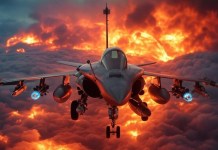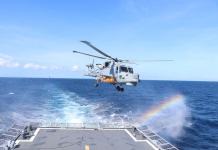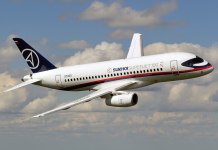The US Air Force (USAF) has finally broken its silence over the ‘striking similarity’ observed between the US F-35 Lightning II and the newly unveiled Chinese stealth aircraft J-35A, days after the latter made its debut at the Zhuhai Air Show amid much fanfare.
Speaking to the Air and Space Forces Magazine in an interview on November 19, the US Air Force Chief of Staff Gen. David W. Allvin said China’s new stealth fighter has one unique feature: it seems to be modeled after the F-35.
He said, “It’s still fairly new. But, yes, it’s pretty clear; you could put it side-by-side and see, at least, where we believe they got their blueprints from, if you will.”
A photo released on November 5 during a PLA Air Force (PLAAF) press conference provided the first look at this advanced aircraft, a key addition to China’s expanding air capabilities.
At the keenly-watched biennial air show, Beijing displayed a variety of modern, state-of-the-art equipment, but the J-35A stealth aircraft remained the show-stopper until the very end. The aircraft also conducted a scintillating demonstration flight, leaving the onlookers in awe of its maneuvers.
The Resemblance Is Uncanny
Since the J-35A aircraft broke cover, its intriguing similarities to the Lockheed Martin F-35 Lightning II have captured the public imagination.
While Gen. Allvin did not elaborate on his statement, the resemblance has once again stirred the discourse about China stealing classified US military technology. Commenting on the aircraft earlier this month, some critics rebuked that the aircraft was copied from the US F-35 Lightning II. For several years, the West has accused China of trying to steal classified information about the F-35 fighter.
Suspicions about China’s “alleged” involvement in F-35 information theft initially came to light after Edward Snowden, a former contractor for the US National Security Agency, disclosed certain confidential documents to a German publication in 2015. The documents allegedly revealed that Chinese hackers gained access to classified data about the F-35.
Some Chinese hackers allegedly caused a data breach at principal subcontractor Lockheed Martin in 2007.
In 2013, Frank Kendall, then the head of defense acquisition, stated during a Senate hearing that he was “reasonably” confident that the F-35’s classified information was secure but “not all confident” about its unclassified information. Additionally, he claimed that “competing powers had forfeited the design and production edge.”
China has, however, refuted these claims and accused Washington of provoking tensions.
The J-35A shares some obvious similarities with the F-35. Like the US F-35 Lightning II, it features a tailplane wing design instead of the canard-wing configuration of China’s first stealth aircraft, the J-20 Mighty Dragon. It also has land-attack capability.

Like the American F-35, the J-35A will also have a carrier-based variant with folded wings called the J-35. The carrier-based J-35 fighter aircraft has already been in the news following its recent tests aboard the People’s Liberation Army Navy (PLAN) Type 001 aircraft carrier, Liaoning. With the addition of the J-35A aircraft to its arsenal, China has become only the second country in the world to have two operational stealth aircraft.
In the photos published online, the J-35A aircraft looks nearly indistinguishable from the F-35, save its engine. While the F-35 is a single-engine fighter, the J-35A is powered by two engines. Moreover, the new Chinese stealth aircraft is “slender and sleeker” than the Lightning II.
The resemblance is so uncanny that even the Pentagon’s F-35 Joint Programme Office (JPO) could not tell the difference. In an embarrassing spectacle last week, the JPO published a poster on social media marking Veterans Day. But there was a catch: the poster featured an image of a twin-engined aircraft that looked like China’s J-35 under the banner of the American flag. Coming under fire for such a bizarre mistake, the poster was taken down from Instagram and X (formerly Twitter).
However, the remarkable resemblance between the two aircraft does not imply that their performances will be comparable, as previously explained by EurAsian Times. An aircraft’s combat capabilities are determined by its engines, sensors, avionics, weapon bay capacity, and stealth features.
It is too soon to determine how well the two fighters compare. Currently, it is unknown whether the J-35 versions feature radar-absorbent coatings, like the F-35, or hard-to-detect communications and radar systems.
However, China’s designation of the aircraft with the number ’35’ has also not helped its case. While some critics dismissed the Chinese aircraft as a copy with no cutting-edge capabilities that could outmatch the F-35, others cautioned against making such a mistake.
“Because of the black box typically surrounding PLA miltech developments, we won’t be too certain of the J-35’s performance,” Collin Koh of the S. Rajaratnam School of International Studies told Reuters. “PRC scientists … have carried out over the years various STEM and advanced studies related to fighter jet tech, including stealth, so I’ll suggest not joining skeptics to dismiss the aircraft outright.”
Several aviation experts emphasized that a resemblance in aircraft does not mean that the aircraft has been copied. They noted that a complex machine like the F-35 Lightning II cannot be copied, and a clearer picture of how these jets compare will only emerge over time.
J-35A Has Set Off Alarm In The US
Citing a necessity to protect sensitive military information, Allvin declined to reveal specifics of what the United States knew about the J-35. However, the USAF boss warned without mincing words, “Overall, I think we should just be very aware of a scope and the scale—if nothing else, the scope.”
However, as the report highlights, the necessity of countering China’s expanding military is a major motivator behind Allvin’s plan to “re-optimize” the U.S. Air Force. Once considered the most powerful military power in the world, the US has been jolted into action, with its supremacy now challenged by Beijing’s rapidly growing capability.
China already operates the J-20 Mighty Dragon fifth-generation stealth aircraft, a twin-seat variant of which was unveiled at the Zhuhai Air Show. The J-20 has now been deployed in all the PLA Air Force theatre commands and is on its way to becoming its mainstay in future combat. The J-20 is also receiving key upgrades to bolster its combat prowess.
Not only that, but China is also working on the next-generation bomber—the H-20—which is believed to be China’s answer to the USAF’s B-21 Raider. Though information about the Chinese bomber is scarce, some Beijing-based military experts hinted earlier that the bomber could be unveiled soon.
Moreover, while the US Next Generation Air Dominance Dominance (NGAD) program has hit rough water amid increased uncertainty over its future, China is working on its sixth-generation fighter jet in earnest. China debuted a mock-up of its sixth-generation fighter jet at the ongoing Zhuhai airshow. The fighter jet, known as the “Baidi” or “White Emperor,” is intended to be an “integrated space-air fighter” that can fly at supersonic speeds and escape Earth’s atmosphere to function in space.

Against that backdrop, it is safe to say that the unveiling of the J-35A has the USAF concerned and forced it to take notes and prepare against a formidable PLA Air Force in the making.
Allvin, nonetheless, stated: “The Chinese development of their capabilities is something we need to respect and be able to account for,” Allvin said. “One thing that they’ll never catch up on us is the quality of our force, the quality of our entire total force, the quality of our [non-commissioned officer corps], the quality of our aviators, the maintainers, all of that. But I don’t want to make it a close fight.”
- Contact the author at sakshi.tiwari9555 (at) gmail.com
- Follow EurAsian Times on Google News




